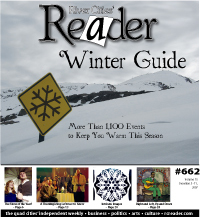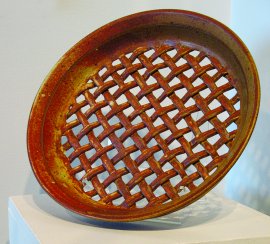 Primal fires transform mud into stone. Tanned-hide-like scrolls stitched together with tea bags evoke tribal dance and hunting rituals. Intricate and whimsical lattice-like snowflake images lighten the spirits. These elemental forces of nature are on display at the Quad City Arts gallery, in the forms of clay works by Sally Gierke and Jim Cronk, cut paperworks by Keith Bonnstetter, and tribal fabric works from Tricia Coulson.
Primal fires transform mud into stone. Tanned-hide-like scrolls stitched together with tea bags evoke tribal dance and hunting rituals. Intricate and whimsical lattice-like snowflake images lighten the spirits. These elemental forces of nature are on display at the Quad City Arts gallery, in the forms of clay works by Sally Gierke and Jim Cronk, cut paperworks by Keith Bonnstetter, and tribal fabric works from Tricia Coulson.
Sally Gierke and Jim Cronk have been working together for more than 30 years producing pottery. Although both artists have a recognizable individuality within their works, a cross-pollination between them can be seen in some of their similar glaze-color and texture palettes, and proportion and balance sensibilities in shaping the clay.
It is important to point out the distinction between the term "ceramics," which encompasses all clay works but tends to be more concerned with sculptural issues and less with utility, and "pottery," which is typically used to describe functional works made from clay such as mugs, cups, casserole dishes, etc. While these categories are not mutually exclusive, any given clay work tends to fall more into one camp than the other.
 But being "functional" does not prevent something from being "art." In reality, the physical and conceptual limitations imposed on an artist trying to create something that is both functional and art make the final piece more impressive when it accomplishes both.
But being "functional" does not prevent something from being "art." In reality, the physical and conceptual limitations imposed on an artist trying to create something that is both functional and art make the final piece more impressive when it accomplishes both.
Sally Gierke's Serving Dish with Coil Handles is a nine-inch oval dish with three-inch sides. The sides have a slightly lustrous and densely spotted oatmeal glaze, which is contrasted with a dry, earthy-brown twisted coil rim. Several of her pieces (along with some of Jim Cronk's) are energized by a subtle, but important, interplay between the matte and glossy surface properties of glazes.
Gierke's ceramic piece Vessel is a four-sided earth-toned slab tower with smoky-gray incisions populating all four sides. Her strong directional strokes are held in check by abundant quasi-floral and biomorphic forms. The smoother and glossier grayish cream inside is a pleasing counterpoint to the drier and texturally active exterior.
Jim Cronk's Two Headed Bottle is one of several captivating pieces. It is a lightly ribbed gray cylinder that flares slightly at the top to accommodate the twin forest-green stacks (spouts) that darken near their rims.
 One of Cronk's most outstanding works is Woven Platter, which is a small clay basket with an open bottom of loosely interwoven clay coils. The grid at the bottom has an exciting synergy with Tricia Coulson's Artifacts: 9 and Artifacts: 8, which are hung nearby and echo a similar visual motif.
One of Cronk's most outstanding works is Woven Platter, which is a small clay basket with an open bottom of loosely interwoven clay coils. The grid at the bottom has an exciting synergy with Tricia Coulson's Artifacts: 9 and Artifacts: 8, which are hung nearby and echo a similar visual motif.
What moves these clay works into the realm of art is Gierke's and Cronk's attention to the "how"s and "why"s behind their pieces. Not only do they value the elements of art (line, shape, value, texture, and color) but also their integration into pottery through the use of proportion and balance, rhythm and movement.
Proportion and balance refer to not only the size relationships between the length of the neck and the body and handle of a piece, but also to how much glossy brown glaze to apply versus the more matte oatmeal color. Playing these ideas off each other creates a satisfying tension throughout a piece.
Through different properties of glazes and the firing temperature of the kiln, the artists can initiate glaze drips to become rhythmic stalactites of color, which move the viewer's attention around a piece. Utilizing dynamic lines and attention-grabbing shapes on both the surface and in the profile of the piece are other ways artists transform function into art.
Keith Bonnstetter's 31 untitled paper cut-outs are excellent examples of the complex interactions between positive space (the white "objects" of the paper) and negative space (the cut-out shapes around the "objects") and a supreme demonstration of focus and patience. His black-and-white works are complex variations on the folded-paper-snowflake project from elementary school. Bonnstetter's pieces are bursting with masks, birds, butterflies, smiling sunflower forms, vines, angels, and clown faces interlocked in a perpetual dialogue between the white and the black shapes.
To say they are "just snowflakes" does not acknowledge the meticulous craftsmanship and conceptual motifs involved in making Bonnstetter's pieces. His shapes (both positive and negative) are far from haphazard. In one work where Bonnstetter has placed a diamond on top of a square to help divide the space, there is an ongoing cat motif in which various interlocking cats (both positive and negative shapes) lead the viewer's eye around the symmetrical composition. Feline profiles, cat paws, and silhouettes of mice emerge from the negative spaces.
 At the entrance to the exhibit, in lieu of an artist's statement, there is an accompanying list of items/objects to look for within Bonnstetter's works, which unfortunately lends his pieces a "Where's Waldo?" vibe. His use of text in some works, such as a "Ho Ho Ho Ho" spiral at the center of a Christmas-themed composition, do not possess irony, innuendo, or double entendre; they are what they are. Their payoff resides in the intoxicating complexity of physical form, not in conceptual nuance or ironic juxtaposition.
At the entrance to the exhibit, in lieu of an artist's statement, there is an accompanying list of items/objects to look for within Bonnstetter's works, which unfortunately lends his pieces a "Where's Waldo?" vibe. His use of text in some works, such as a "Ho Ho Ho Ho" spiral at the center of a Christmas-themed composition, do not possess irony, innuendo, or double entendre; they are what they are. Their payoff resides in the intoxicating complexity of physical form, not in conceptual nuance or ironic juxtaposition.
Tricia Coulson visually realizes the yearning of so many Modernist artists (such as Paul Gaugin, Karel Appel, and Pablo Picasso): to capture the spontaneity and vibrant essence of the works produced by pre-civilized and non-Western-civilized image makers. The often celebrated "uncontaminated" natural honesty and vitality of works from African, Oceanic, and Native American artists have been high-octane sources of inspiration and imitation for Western artists for nearly a century.
By successfully tapping into that raw, wild immediacy, Coulson has created her own pantheon of images in a primitive style. Her repeated use of easy-to-comprehend symbols - such as dancing warrior figures, spirals of cosmic, vertebrae-like particles, letters/glyphs that conjure an ancient language dripping with forgotten wisdom, and a broken tic-tac-toe grid that periodically provides an organizational structure to her visceral images - add up to some powerful pieces. Her works resonate by how these ingredients are used to create passages of deep receding "picture" space, contrasted with areas of shallower space.
Coulson's use of letters/glyphs becomes a strong compositional force by not only guiding your eye around the piece, but also because of the nature of text itself. Something that seems like it should be readable, but cannot be deciphered, immediately prompts questions and a sense of unease. In that sense, it has a similar effect to asymmetrical compositions; it generates interest. Passages of text in artwork also trigger an automatic scanning/reading response.
 The lack of specificity in Coulson's use of "typography" allows for more-sophisticated interpretations than Bonnstetter's straightforward use of text. Coulson's "words" can be undecipherable ancient narratives or mystical glyphs of druidic incantations. Their presence without explanation places more of the interpretive work on the viewer. The intrigue and anticipation of what they might mean is a more charged experience than actually knowing.
The lack of specificity in Coulson's use of "typography" allows for more-sophisticated interpretations than Bonnstetter's straightforward use of text. Coulson's "words" can be undecipherable ancient narratives or mystical glyphs of druidic incantations. Their presence without explanation places more of the interpretive work on the viewer. The intrigue and anticipation of what they might mean is a more charged experience than actually knowing.
Pictograph is a series of stained/dyed tea bags stitched together to form a roughly 30-by-30-inch picture surface. There are several rust-colored figures of a dancing person scattered about the surface that are balanced by numerous charcoal-gray warrior figures carrying a trident and a spear.
In a surprisingly contemporary yet satisfying use of materials, Coulson has also included some pink and gold swirls and shiny blue wedges that are reminiscent of spear points. The potential for the modern shininess of the blue and gold to undermine the overall primitive or tribal mood of the piece is neutered by their playful shapes and Coulson's minimal use of those colors. They are small active elements that serve to guide the viewer's attention, but fundamentally they are a subtle undercurrent. The overall effect is one of a cured animal hide riddled with images of shamanistic rituals and prehistoric insight.
The exhibit is full of small visual surprises, and it's rewarding to see the refined products of intricate image makers. With more than 80 works, the show is a robust sample of what these artists have to offer. It runs through December 28 at Quad City Arts and will be part of the Gallery Hop! festivities on Friday, December 7.










